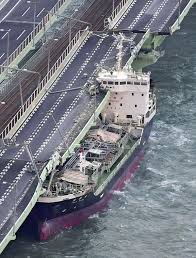Typhoon No. 21 batters central, western Japan

TOKYO (Jiji Press) — A very strong typhoon brought heavy rain and strong winds across Kinki and Shikoku regions of western Japan, and Tokai and Hokuriku regions on Tuesday, killing one person in the Kinki region.
Typhoon No. 21 landed in the southern part of Tokushima Prefecture in the Shikoku region around noon. It made a second landfall in Kobe around 2 p.m. after traveling over Awaji Island in Hyogo Prefecture, the Japan Meteorological Agency said.
The typhoon later reached the Sea of Japan off Maizuru, Kyoto Prefecture.
The agency warned residents to be on high alert for heavy rain, violent winds, high waves, landslides, inundation of lowland areas and river swelling. The typhoon caused high tides in coastal areas of the Kinki region.
In Higashiomi, Shiga Prefecture, a warehouse collapsed and a 71-year-old man was crushed to death, according to sources including the police department of the prefecture.
From Tuesday night to Wednesday morning, Typhoon No. 21 is expected to travel north over the Sea of Japan off the Tohoku region and Hokkaido, and then turn into an extratropical cyclone, the agency said.
It is the first typhoon to land on Japan with a maximum sustained wind speed of 44 meters or more per second since the 13th typhoon of 1993, according to the agency.
Kansai International Airport, located on a manmade island in Osaka Prefecture, registered a maximum instantaneous wind speed of 58.1 meters per second around 1:40 p.m., and Wakayama registered 57.4 meters per second around 1:20 p.m.
Awaji, Hyogo Prefecture, had a rainfall of 85.5 millimeters in just one hour until around 1:10 p.m.
A 2,591-ton tanker crashed into a bridge connecting the Kansai airport and the opposite shore around 1:30 p.m.
According to sources including at the Japan Coast Guard’s fifth regional headquarters in Kobe, none of the 11 crew members onboard was injured in the incident, believed to have been caused by strong winds from the typhoon.
Sediment disaster warnings were issued in Kagawa, Tokushima, Kyoto, Nara and Wakayama prefectures. Evacuation orders were issued for some areas in such municipalities as Kobe and Sanuki, Kagawa Prefecture.
One person each was slightly injured in Mie and Kagawa prefectures, according to the Fire and Disaster Management Agency.
At 3 p.m., Typhoon No. 21 traveled at a point 40 kilometers east-northeast of Maizuru at a speed of about 65 kilometers per hour. It had a central atmospheric pressure of 960 hectopascals, a maximum sustained wind speed of 40 meters per second and a maximum instantaneous wind speed of 55 meters per second, the agency said.
Until Wednesday, the maximum instantaneous gust speed is estimated at 50 meters per second in Kinki, Tokai and Hokuriku regions, 45 meters per second in the Tohoku region and Hokkaido, and 35 meters per second in Chugoku, Shikoku, Kanto and Koshin regions and the Izu Islands off Tokyo, according to the agency.
The height of waves is projected to reach up to 10 meters in the Tokai region, up to nine meters in the Kinki region, up to eight meters in the Izu Islands, up to seven meters in the Shikoku region and up to six meters in Hokuriku, Kanto, Tohoku regions and Hokkaido.
In the 24 hours until 6 p.m. Wednesday, the maximum rainfall is projected at 300 millimeters in the Tokai region, 200 millimeters in Kanto and Koshin regions, 180 millimeters in Hokkaido, 150 millimeters in Hokuriku and Tohoku regions, and 100 millimeters in the Kinki region.
Source:the-japan-news.com